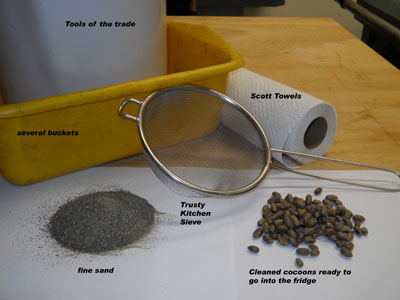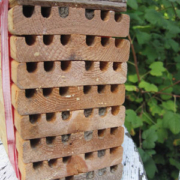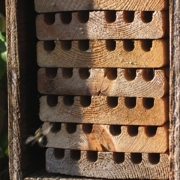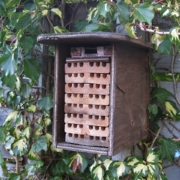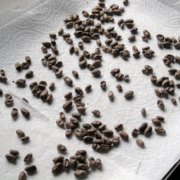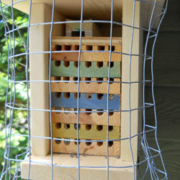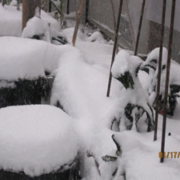A Quicker Way To Clean Mason Bee Cocoons
by Brian
Have you opened and cleaned your mason bee condos yet? If not, you should be planning to do this soon, and then get the cocoons into the fridge, in a ziplock bag, to delay emergence until the timing is right for pollination. I opened and cleaned my condos a few days ago and I tried a different method for cleaning the cocoons, using fine sand to scour them, a bit like using Vim on your countertops.
Using sand worked a lot faster and resulted in much cleaner cocoons than the “multiple rinse” system, and I’ll be using it from now on. I have a garbage can of coarse builder’s sand that I use on my driveway when it’s icy, and I made use of that, but sifted it first (with one of those handy kitchen sieves) so that in a small bucket I ended up with a few cups of fine sand. The photo shows everything you need for this project.
After the cocoons are scraped out of the channels into a bucket, add enough water to moisten everything, let it soak for 5 minutes and then scoop out perhaps 40 or 50 cocoons at a time with your trusty sieve and quickly rinse away most if the dirt, leftover pollen, mites or mite eggs (lots this year because of the wet Spring) and mite feces (the yellow stuff in compartments that don’t have a cocoon in them).
With the cocoons still in the sieve, and working above a bucket, sprinkle enough sand onto the moist cocoons until they are thoroughly covered in a sandy paste. Then swirl and swish this mixture around for a minute or two. The polishing action of the sand quickly removes any remaining detritus and a quick rinse shows very clean cocoons. I repeated the process one more time, rinsed thoroughly, and then placed them on Scott towels to dry. Clean cocoons leave almost no trace of yellow on the paper and I was able to achieve, with two quick sand washes, what used to take four or five long soakings and rinses. Be sure to let the cocoons dry thoroughly, in a cool place, and then get them into the fridge. I put mine in a small paper bag and then inside a sealed ziplock bag.
A word of caution about this system: sand is a great blocker of drains, so I worked and rinsed entirely into buckets and tossed the residue outside, and so should you. Lastly, go quickly now into the kitchen and replace your (spotlessly clean) sieve before anyone notices what you’ve been up to.
